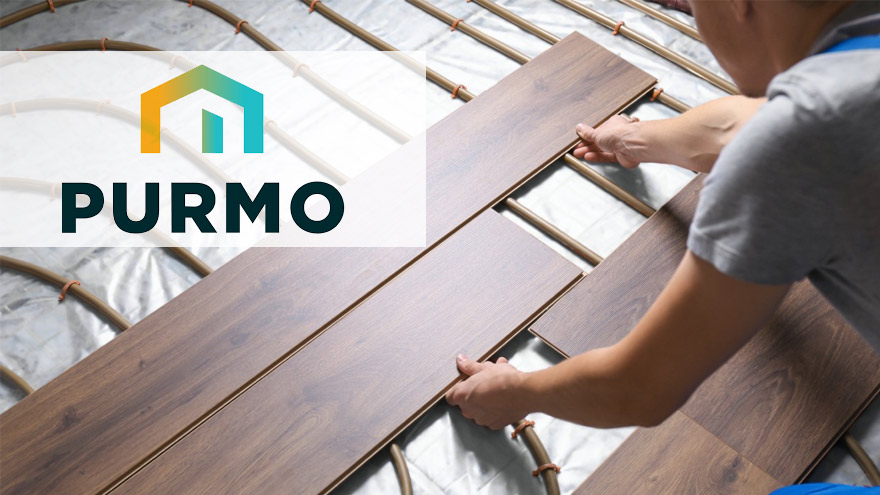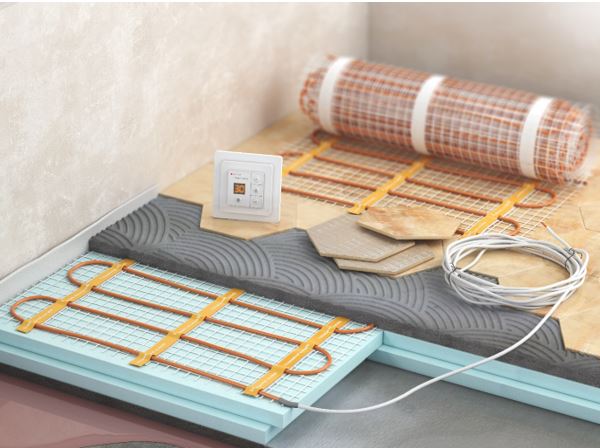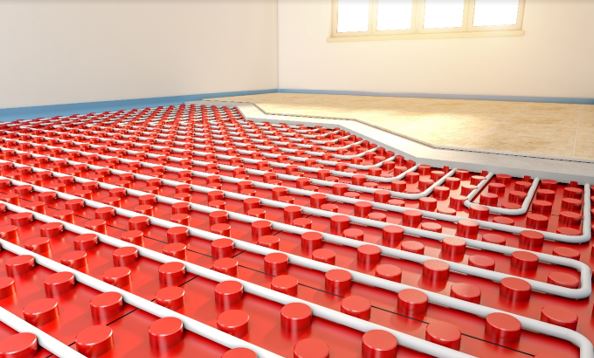Underfloor heating is increasingly replacing classic radiators . They are used in single-family houses, multi-family buildings, utility rooms and offices. Even though its installation is more complicated and the price is higher, the ongoing operating costs decrease after some time. Interested? We cordially invite you to read it.

From this text you will learn:
- how underfloor heating works,
- what is the difference between electric underfloor heating and water installation,
- what pipe systems and underfloor heating circulation systems are available.
Underfloor heating - principles of operation and basic information
The installation of underfloor heating became popular when residential and commercial buildings began to be better insulated. Relatively low fuel consumption and thermal comfort are advantages of using this type of heating. The floor emits heat evenly over its entire surface and is slightly warm to the touch. All this means that it is possible to maintain the ideal temperature in a room with underfloor heating (also in winter in rooms with tiles and stone, i.e. "cold" materials). A floor made of ceramic tiles will conduct heat best and will not be damaged by temperature. Underfloor heating can be the primary source of heat throughout the house, as well as an "additional" source in selected rooms (e.g. bathrooms), used to "insulate" only selected places at a specific time (e.g. in the cold or after getting out of the shower).
Compared to radiator heating, in the case of underfloor heating we are dealing with low-temperature heating, which takes time - it heats up slowly and cools down slowly . Heat is radiated through the entire floor surface. Even though at first glance it seems more expensive and complicated to install, its heating efficiency is greater and it is cheaper to operate than radiator heating.
Check out PURMO products for underfloor heating
Electric underfloor heating or water underfloor heating? Differences and characteristics

There are two basic types of underfloor heating . In the first type - electric underfloor heating - mats, resistance foils or wires are installed under the floor, which generate heat when connected to a power source . In turn, the second type - water installation - is characterized by pipes installed under the floor through which hot water flows. It is heated by a heat pump or boiler. Regardless of which underfloor heating you choose, remember to use polystyrene or stiff wool to prevent heat from escaping towards the ground.
Electrical installation - characteristics
Cables embedded in the screed, heating foils or mats can be placed directly under the panels or tiles. If you decide to use cables, remember that you also need to use tapes or mesh insulating the insulation layer. Electric "underfloor heating" is relatively easy to install - it does not require additional devices such as a pump or boiler (they are necessary for the water installation). This solution does not require a screed of several centimeters, which is why it is perfect for buildings where it is impossible to thicken the floor. Electric underfloor heating simply needs to be connected to an electric installation box, and its costs will be included in your electricity bills. This is a more expensive solution to operate than the water version (which we write about below), but it is easier to install. Its costs can be reduced by using the increasingly popular photovoltaics.
Exchange benefits in the new OnnTop loyalty platform!
Water installation - characteristics
In turn , installing water underfloor heating is slightly more complicated - it requires extremely precise planning of the arrangement of pipes and their number, and installation requires precision. Water underfloor heating is performed using PEX, PP or PB pipes, copper models (less frequently used). You will find such products in the PURMO offer, available at Onninen. The tubes are placed on a special silver foil (we place this on the insulation layer), which has lines printed on it, telling you where to place the tubes. They must be no less than 10 centimeters and no more than 30 centimeters apart. All pipes must be securely fastened so that they do not change their position while pouring the floor. Sometimes they are mounted to system boards, which are covered with a dry and light screed.
Water underfloor heating in a single circuit should not be longer than 150 meters. This will avoid pressure losses, which is why in single-family houses that are heated only with water underfloor heating, the number of installed circuits may consist of a dozen or so. To improve the effectiveness of the installation, it is worth investing in an appropriate boiler or pump , as well as using an anhydrite screed (with higher thermal conductivity parameters than cement mortar).
Pipe system - available types

We distinguish the following pipe and cable systems:
- loop system, called "snail" - ensures even temperature distribution over the entire floor surface,
- "snail" with a peripheral zone,
- meandering - used in rooms with wooden floors or in rooms with partitions with higher heat losses,
- meandering with a coastal zone,
- cochlear with a separate edge zone.
Selection of cables and their fastening
Plastic polyethylene pipes are used for the underfloor heating system. The basic type is a PE-X pipe made of cross-linked polyethylene . PE-RT pipe is used less often - a pipe made of refined polyethylene, which has slightly lower resistance to high temperatures. The methods of attaching cables to the ground are similar. This requires a special clip that is attached to the cable using the so-called tacker . The clips are spaced every 50 cm, and more clips are used on bends in the cables. When we are dealing with systems with protrusions, the cables are laid by pressing them between the protruding protrusions.
Underfloor heating circulation systems
There are two underfloor heating circulation systems depending on the facility - wet and dry. The first one is more popular - central heating pipes are embedded in a layer of cement or anhydrite screed. Insulation is made of polystyrene boards with foil. The lower layer is a polystyrene board with protrusions on the surface (heating pipes are placed between the protrusions) and the upper layer is a damage-resistant polystyrene foil. Closed-cell polyurethane foam is also used for insulation in industrial or exhibition facilities .
Read about the advantages of underfloor heating!
Dry underfloor heating is less frequently used, especially where a wet system cannot be used. For example, in old buildings that are undergoing renovation, or new ones that use a light wooden ceiling on joists. These types of ceilings do not allow for heavy concrete screeds. The dry system consists of profiled polystyrene boards, for example made of galvanized steel sheet , which improves heat conduction and keeps the heating pipes in the system board.
Summary
To effectively increase the temperature in the room, we can use the so-called "underfloor heating". You already know what versions of underfloor heating are available on the market, what installation looks like and what are the advantages of this type of solutions . Traditional radiators are slowly being replaced by heated floors. See for yourself how convenient they are!
Do you have questions about the industry? Join the Świat Instalacji group!